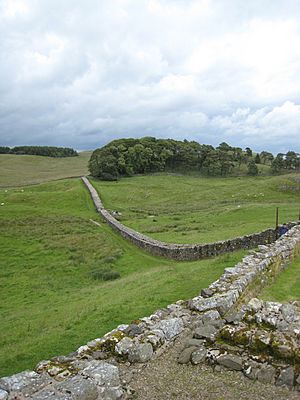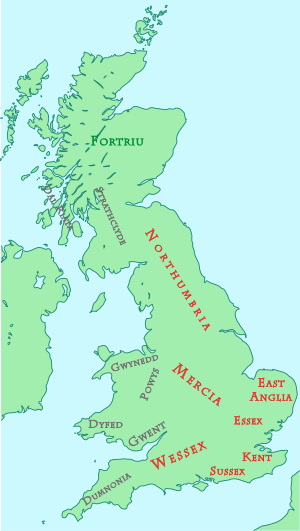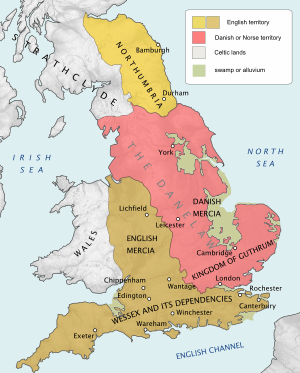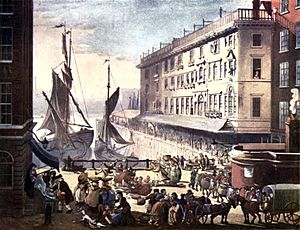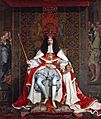History of England facts for kids
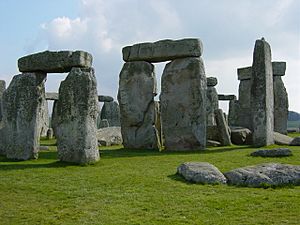
People first lived in England about 41,000 to 44,000 years ago. More people settled there around 13,000 years ago. This was at the end of the last Ice Age. Famous ancient sites like Stonehenge and Avebury are from the Bronze Age. Later, during the Iron Age, people called Celtic Britons lived in England. In AD 43, the Romans invaded. They controlled their land, called Britannia, until the early 5th century.
After the Romans left, the Anglo-Saxons settled in England. Many historians see this as the start of England and the English people. The Anglo-Saxons were groups of Germanic peoples. They formed several kingdoms that became powerful in England and parts of southern Scotland. They brought the Old English language and often fought over land. After AD 800, Vikings attacked and settled in parts of England. During this time, different rulers tried to unite the Anglo-Saxon kingdoms. This led to the Kingdom of England being formed by the 10th century.
In 1066, the Normans invaded and took over England. The Norman Dynasty, started by William the Conqueror, ruled for over 50 years. Then came a time of trouble called the Anarchy (1135-1154). After this, the House of Plantagenet ruled. This family later had claims to the French throne. A problem with who would be king in France led to the Hundred Years' War (1337–1453). This was a long series of fights between England and France. After this war, England had its own fights over who should rule. The Wars of the Roses were battles between two branches of the Plantagenet family: the House of York and the House of Lancaster. Henry Tudor from the Lancastrian side ended the war and started the Tudor dynasty in 1485.
Under the Tudors and later the Stuart family, England began to create and rule colonies around the world. During the Stuart rule, the English Civil War happened. It was fought between Parliament's supporters and the King's supporters. This war led to King Charles I being executed in 1649. England then became a republic, first as the Commonwealth of England (1649-1653). Then, Oliver Cromwell led a dictatorship called The Protectorate (1653-1659). In 1660, the Stuarts returned to the throne. But England struggled to decide if it wanted to be Catholic or Protestant.
In 1707, England and Scotland joined to form Great Britain. Over the next 300 years, most of Great Britain's colonies became independent countries. This process is called decolonization.
Contents
- Ancient Times: The Stone Age
- Later Prehistory: Bronze and Iron Ages
- Roman Rule in Britain
- The Anglo-Saxon Era
- Christianity Comes to England
- Vikings and the Rise of Wessex
- Danish Rule and the Norman Conquest
- Norman England: A New Era
- England Under the Plantagenets
- England in the 14th Century
- 15th Century: Henry V and the Wars of the Roses
- Tudor England: A New Dynasty
- England in the 17th Century
- Forming the United Kingdom
- Modern England: 18th and 19th Centuries
- England in the 20th and 21st Centuries
- Fun Facts About England's History
- Images for kids
- See also
Ancient Times: The Stone Age
How did people live in the Stone Age?
The Stone Age is split into three parts:
- The Old Stone Age, or Palaeolithic, had people who were hunter-gatherers. They found food by hunting animals and gathering edible (safe to eat) plants. It's thought that Britain was connected to Europe then because sea levels were low.
- The Middle Stone Age, or Mesolithic, saw more advanced tools. Simple weapons like javelins, bows and arrows, and possibly slings were found. Sea levels rose during this time, separating Britain from Europe.
- The New Stone Age, or Neolithic, started around 4,000 BC. People began to farm crops and raise animals. They lived in settled communities. Huge tombs for many dead people have been found. Other stone structures, like Stonehenge, were likely built then. These amazing stone circles line up with stars, showing how smart the builders were. People also developed flint tools, making useful and artistic items.
Later Prehistory: Bronze and Iron Ages
What happened in the Bronze Age?
The Bronze Age began around 2500 BC. People used bronze to make many objects found by archaeologists today. During this time, people started caring more about themselves than the community. Some people became powerful and controlled valuable resources. More weapons were made, and beautiful metal items have been found. England also started trade with other parts of Western Europe. This trade influenced English culture. It's possible that Celtic languages came to England because of this trade.
How did the Iron Age change England?
The Iron Age started around 800 BC. During this time, burying the dead seems to have stopped. Hillforts were known before, but many more were built between 600–400 BC, especially in the South. This is when Britain first appeared in history books. The earliest mentions are from old sailing guides and writings by Pytheas of Massilia. Trade continued, but less than in the Bronze Age.
Battles also happened as powerful leaders formed new towns called oppida instead of hillforts. In 55 and 54 BC, Julius Caesar invaded Britain as part of his wars in Gaul. He claimed to win many battles.
Roman Rule in Britain
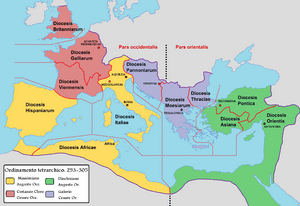
After Julius Caesar, the Roman Emperor Claudius began to conquer Britain in AD 43. By AD 60, much of England was under Roman control. The warrior-queen Boudicca led a revolt against the Romans. Some Roman cities were burned. But Boudicca was defeated. Over the next 20 years, the Roman borders grew. Northern England and Wales became Roman. The border became strong along the Stanegate in Northern England. Hadrian's Wall was built along this line in AD 138. The Romans stayed for 350 years, and their culture greatly affected England.
The Anglo-Saxon Era

After the Romans left Britain in the mid-4th century, Germanic groups gradually settled in what is now England. These groups were the Angles, the Saxons, and the Jutes. Together, they were called "Anglo-Saxons." The region was known as "Hwicce," and southern settlements were called Gewisse. The Battle of Deorham in 577 was important for establishing Anglo-Saxon rule.
It's hard to know exactly what happened in the 5th and 6th centuries because of myths. Stories mention figures like Hengist and Horsa, Ambrosius Aurelianus, and King Arthur, along with their legends.
Seven kingdoms were formed. Wessex was in the South. Sussex, Kent, and Essex were in the Southeast. Mercia and East Anglia were in the middle. Bernicia and Deira joined to form Northumbria in the North. Northumbria later conquered parts of Scotland and Wales. Mercia became the main power in the 8th century. Wessex then grew and became the main power in the 9th century.
Christianity Comes to England
The Christianization of Anglo-Saxon England began around AD 600. It was influenced by Celtic Christianity from the northwest and the Roman Catholic Church from the southeast. Augustine, the first Archbishop of Canterbury, started his work in 597. In 601, he baptized the first Christian Anglo-Saxon king, Aethelbert of Kent. When the last pagan Anglo-Saxon and Jutish kings died, Christianity became the official religion of England. The Anglo-Saxon mission sent missionaries to Europe in the 8th century. This helped spread Christianity across almost all of the Frankish Empire by 800.
Vikings and the Rise of Wessex
Vikings started attacking in the late 700s. The arrival of the Vikings, especially the Danish Great Heathen Army, made life hard for people in Britain and Ireland. In 867, Northumbria fell to the Danes. East Anglia fell in 869. Wessex defeated the Vikings at Ashdown in 871. But a second Viking army landed. Around this time, Æthelred, king of Wessex, died. His younger brother Alfred became king. Alfred spent his first five years paying the invaders to leave. In 878, Alfred's forces were defeated at Chippenham in a surprise attack.
Alfred then showed he was a great king. In May 878, he led his army to defeat the Danes at Edington. The victory was so complete that the Danish leader, Guthrum, had to become Christian and leave Mercia. Alfred then made Wessex stronger and built a new navy of 60 ships. Alfred's success gave Wessex and Mercia years of peace. They could rebuild their lands that had been attacked.
Alfred's son Edward continued his father's success. He added East Anglia to his rule. Wessex kept growing when Edward's son Æthelstan conquered the Kingdom of York in 927. He also attacked Scotland by land and sea. He was the first to call himself "King of the English."
The next kings kept England independent. But in 978, when Æthelred the Unready was king, the Danish threat returned. Two powerful Danish kings, Harald Bluetooth and later his son Sweyn, both invaded England. They kept attacking. For almost 20 years, Æthelred paid more and more money to the Danish nobles to stop them. These payments, which became very expensive, were called Danegelds.
Æthelred then made an alliance with Normandy in 1001. He married the Duke's daughter, Emma. He hoped this would make England stronger. However, in 1002, he ordered all Danes in England to be killed. This was a huge mistake. The Danes fought back, and a Danish king named Cnut crowned himself King of England.
Danish Rule and the Norman Conquest
Cnut's sons became kings after him. But in 1042, the English-born Edward the Confessor became king. Edward had no son to inherit the throne. So, a big argument started over who would be king after his death in 1066. Edward had been protected in Normandy by his cousin, Duke William. Edward had promised William the throne. Godwin, Earl of Wessex, thought he should be king, and so did Cnut's Scandinavian relatives.
Harold Godwinson became king. Edward the Confessor likely chose him on his deathbed, and the Witan (a council of wise men) agreed. But William of Normandy, Harald Hardråde (King of Norway, helped by Harold Godwinson's brother Tostig), and Sweyn II of Denmark all said they should be the next king.
In September 1066, Harald III of Norway landed in Northern England. He had about 15,000 men and 300 longships. Earl Tostig was with him. Harold Godwinson defeated and killed Harald III and Tostig at the Battle of Stamford Bridge.
On September 28, 1066, William of Normandy invaded England. This was called the Norman Conquest. On October 14, Harold Godwinson's tired army marched from Yorkshire to fight the Normans at the Battle of Hastings. England's army was defeated, and Harold was killed. Edgar the Ætheling was most closely related to Edward. He was young and didn't have strong supporters. But the Witan made him king for a short time after Harold died. William was crowned king on Christmas Day 1066.
Norman England: A New Era
After his coronation, William immediately strengthened his power. By 1067, he faced rebellions everywhere. He spent four years crushing them. He then forced Scotland and Wales to accept him as their ruler.
The Norman Conquest greatly changed England. William ordered a report called the Domesday Book. It listed all people, lands, and property for taxes. The Domesday Book showed that within 20 years, Norman landowners had replaced almost all the English ruling class. They also took powerful positions in government and the Church. William and his nobles spoke Norman French in England and Normandy. This language was used by the upper class for centuries and helped create modern English.
England produced plenty of food like cereals, dairy, beef, and mutton. Wool was sent to Flanders to be made into cloth. England then traded this cloth with other countries to make money.
Henry I, William the Conqueror's fourth son, became King of England in 1100. He was also called "Henry Beauclerc" because he was educated. His older brother William had been trained to be king. Henry worked hard to smooth out differences between Anglo-Saxon and Anglo-Norman societies.
Before he died, Henry I made important nobles and church leaders promise to accept his daughter, Matilda, as his heir. But England did not want an outsider, and a woman, as their ruler. When Henry died, the Norman and English nobles ignored Matilda's claim. Stephen, Henry's favorite nephew, was welcomed as the new ruler.
On December 22, 1135, Stephen was crowned king. Matilda waited in France for a chance to fight. In autumn 1139, Matilda invaded England with her half-brother Robert of Gloucester. Her husband, Geoffroy V of Anjou, conquered Normandy but didn't help his wife in England. During this time, nobles built castles without permission. These were called adulterine castles.
Stephen was captured, and Matilda was declared queen. But she was soon removed from London. Civil wars followed. In 1148, Matilda returned to France. Stephen ruled until his death in 1154. He had most of the illegal castles torn down. Feudal nobles gained more power, and civil war and lawlessness broke out. Stephen also gave away large areas of land to Scottish and Welsh raiders to make peace.
England Under the Plantagenets
Empress Matilda and Geoffroy's son, Henry of Anjou, became king after Stephen. Henry was also the Count of Anjou and Duke of Normandy and Aquitaine. He became Henry II and destroyed the remaining illegal castles. He expanded his power into Ireland, Scotland, Wales, and parts of France.
During Henry II's rule, power moved away from the nobles and the Church. The king gained more power. Society started to move away from feudalism, a system where land was exchanged for loyalty and service. New upper classes, called Anglo-Angevin and Anglo-Aquitanian aristocracies, developed.
Henry's son, Richard I "the Lion Heart," was known as "the absent king." He took part in the Third Crusade and was captured on his way home. His younger brother, John, became king after him. John lost many of Richard's lands, including Normandy, after the terrible Battle of Bouvines in 1214.
From 1212, John kept close ties with the Pope. This helped him persuade the Pope to say the Magna Carta was not valid.
The Magna Carta: Limiting the King's Power

King John was unpopular with his nobles because of high taxes, lost wars, and fights with the Pope. In 1215, some important nobles rebelled against him. John met with English leaders and their French and Scottish allies at Runnymede. There, he sealed (like an official signature) a document called the Magna Carta. This "Great Charter" (Magna Carta in Latin) limited the king's power. John got the Pope's approval to break his promise later, saying he was forced to sign. This started the First Barons' War.
John's son, Henry III, was only 9 when he became king (1216–1272). He didn't like the Magna Carta rules. But he was forced to call the first "parliament" in 1264. Henry III faced many rebellions and civil wars, including the Second Barons' War.
England in the 14th Century
Edward I (ruled 1272–1307) made his government stronger. He brought together the Parliaments of England, like his Model Parliament. He conquered Wales and tried to conquer Scotland. William Wallace, a Scottish knight, gathered troops to fight Edward. Wallace was eventually defeated, but he inspired other Scots to fight for freedom.
Edward I's son, Edward II, was a weak king. He spent most of his rule trying to control the nobles. Meanwhile, the Scottish leader Robert Bruce began taking back all the land Edward I had conquered. In 1314, the English army was badly defeated by the Scots at the Battle of Bannockburn. Edward's wife, Queen Isabella, went to France. Then, with Roger Mortimer, she invaded England. Edward fled to London, was removed from power, and later murdered.
Millions of people in northern Europe died in the Great Famine of 1315–1317. In England, over 500,000 people died, which was more than 10% of the population.
Edward III, son of Edward II, became king at 14. His mother and Roger Mortimer had removed his father from power. At 17, Edward III led a successful takeover against Mortimer, who was really ruling the country. Edward III ruled from 1327–1377. He brought back royal power and made England the strongest military power in Europe. During his rule, the Black Death (a terrible plague) happened. He also claimed he was the rightful heir to the French throne. This started the Hundred Years' War.
In 1373, England signed an alliance with the Kingdom of Portugal. This is said to be the oldest alliance still in effect today.
In 1381, a Peasants' Revolt led by Wat Tyler spread across much of England. Richard II stopped it, and 1500 rebels died.
In 1399, Henry IV became king. He spent most of his rule defending against plots, rebellions, and murder attempts.
15th Century: Henry V and the Wars of the Roses
Henry V became king in 1413. He started a new part of the Hundred Years War, called the Lancastrian War. In the Treaty of Troyes, Henry V was given the right to become the next ruler of France, after Charles VI of France. He also married Charles VI's daughter. Henry V and Catherine of Valois married in 1421. But Henry V died of dysentery in 1422. His plans to become King of France and lead a crusade to take back Jerusalem were left unfinished.
Henry V's son, Henry VI, was a baby when he became king. So, England was ruled by the Regency Government of England. The council tried to make Henry VI king of France. But in 1429, Joan of Arc began leading the French military. With her help, French soldiers pushed back the English forces. The French regained control of their land.
Henry VI began ruling as king in 1437. He married a French noblewoman, Margaret of Anjou, in 1445. England lost the Hundred Years War in August 1453. Henry then had a mental breakdown. A civil war, known as the Wars of the Roses (1455–1485), began. This was because Henry couldn't control the nobles, who were fighting each other.
Henry's cousin, Edward IV, removed Henry from power in 1461 and became king. He brought power back to the crown. But he died at only 40 years old.
Edward's brother, Richard, Duke of Gloucester, declared himself king. Edward's sons, Edward V and Richard, were imprisoned in the Tower of London. It's believed that Richard III had his nephews killed so he could be king.
In summer 1485, Henry Tudor, the last male from the Lancastrian side, landed in England. He had been living in France. He defeated and killed Richard in battle at Bosworth Field on August 22. Henry Tudor became king as Henry VII. The Battle of Bosworth Field is seen as the end of the Middle Ages in England.
Tudor England: A New Dynasty
Henry VII: Uniting the Houses
Henry VII became king in 1485, ending the Wars of the Roses. To keep peace between the two fighting families, he married Edward IV's oldest daughter, Elizabeth, in January 1486. This united the houses of York and Lancaster. The Tudors would rule England for 118 years.
Henry VII had to defend his position from others who wanted to take his throne. But he was successful. When his country was peaceful, two of his children married foreign royals. His son Arthur married Catherine of Aragon, daughter of Ferdinand and Isabella of Spain. Henry's daughter Margaret married James IV of Scotland.
In 1501, King Henry's son Arthur died at age 15. He had just married Catherine of Aragon. When King Henry VII himself died in 1509, the Tudor family's position was finally secure. His younger son and heir, Henry, Duke of York, became King Henry VIII without any problems.
Henry VIII: A Powerful King
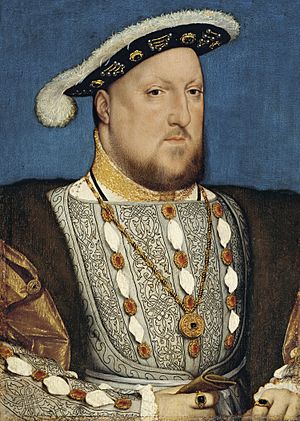
Henry VIII was a strong, athletic young king. He seemed set for a successful rule. He married Catherine of Aragon after his brother Arthur died. They had several children, but only a daughter, Mary, survived.
In 1512, Henry VIII wanted to be a victorious king. He started a war in France. Meanwhile, James IV of Scotland (Henry's brother-in-law) sided with the French. He declared war on England. At the Battle of Flodden on September 9, 1513, the Scots were completely defeated. Most of the Scottish nobles and King James himself were killed. When Henry returned from France, he was given credit for the victory, even though he wasn't there.
He later divorced Catherine. He had several other wives and children.
In 1542, Henry started another war with France. He only managed to conquer the city of Boulogne. The French took Boulogne back in 1549. Scotland also declared war. At Solway Moss, Scotland was again totally defeated.
As he got older, Henry became more paranoid and suspicious. Tens of thousands of people were executed during his 38-year rule. He died in January 1547, at age 55. His son, Edward VI, became king.
Edward VI and Mary I: Religious Changes
Edward VI was only nine years old when he became king in 1547. His uncle, Edward Seymour, 1st Duke of Somerset, changed Henry VIII's will. He gained much of the power of a monarch by March 1547. Seymour took the title of Protector. Many people protested because they didn't like Seymour's power. John Dudley, also known as Lord President Northumberland, removed him from power. Northumberland took power himself. But he consulted the council more, so they accepted him. During Edward's reign, England became a Protestant nation instead of a Catholic one.
Edward seemed like he would be a great king. But he became very ill with tuberculosis in 1553 and died that August. He would have been 16 in two months.
Mary I (1516–1558) then took the throne. She was very popular in London at the time. Mary was a strong Catholic. She believed she could return England to how it was before the Protestant Reformation.
Bringing England back to Catholicism led to the burning of 274 Protestants. These events are recorded in John Foxe's Book of Martyrs. Mary then married her cousin Philip, son of Emperor Charles V and king of Spain. Philip was not popular in England. He was Catholic and king of Spain, a country at war with France. France didn't like being surrounded by Habsburgs (the ruling family of Spain). This made France unfriendly with England. It's believed Mary died of uterine cancer in November 1558. Her death was celebrated in London.
Elizabeth I: The Golden Age
The rule of Elizabeth I brought order after the difficult reigns of Edward VI and Mary I. The religious issues that had divided the country since Henry VIII were settled. The Elizabethan Religious Settlement re-established the Church of England. Elizabeth balanced the interests of Puritans and Catholics, keeping peace.
Elizabeth did not want to marry. This meant it was never clear who her heir would be.
Except for the Revolt of the Northern Earls in 1569, Elizabeth kept the government stable. She ruled all of England, and the population grew. From 1564 to 1616, the population grew from three million to almost five million.
Elizabeth's cousin, Mary, Queen of Scots, was a devoted Catholic. She was forced out of Scotland because it had become Protestant. Mary fled to England, where Elizabeth arrested her. After 19 years, many people still believed Mary was the true ruler of England. So, Elizabeth had her tried for treason. Mary was sentenced to death and beheaded in February 1587.
The Elizabethan Era: A Time of Flourishing
Queen Elizabeth I's rule, from 1558–1603, is called the Elizabethan Era. It's known as a golden age in English history. Arts, a strong economy, and peace were present.
Poetry, music, and literature thrived. William Shakespeare and others wrote plays different from England's past theatre style. England sent out explorers and expanded its territory. The country did well economically because of trans-Atlantic trade. France and England paused their conflict. This was because France had its own religious battles, and English troops were no longer in France. Philip II of Spain tried to invade England with the Spanish Armada in 1588. But he was famously defeated. The Protestant Reformation became more accepted, even though most nearby countries were Catholic. This era also marked the end of England as a separate kingdom before its union with Scotland.

Elizabeth's Foreign Policy
Elizabeth was careful in foreign affairs. She risked war with Spain by supporting "Sea Dogs" like Walter Raleigh, John Hawkins, and Sir Francis Drake. These men attacked Spanish merchant ships carrying gold and silver from the New World. During the Anglo-Spanish War, Spain tried to invade England. The Spanish Armada was defeated in 1588. Elizabeth's name is remembered with this victory.
England in the 17th Century
Union of the Crowns: One King for Two Kingdoms
Elizabeth died in 1603 at age 69. Her closest male Protestant relative was the King of Scots, James VI. He became King James I of England in a Union of the Crowns. King James I & VI was the first monarch to rule the entire island of Great Britain. When he took power, James immediately made peace with Spain. For the first half of the 17th century, England stayed out of European politics.
Colonial Expansion: New Lands Across the Sea
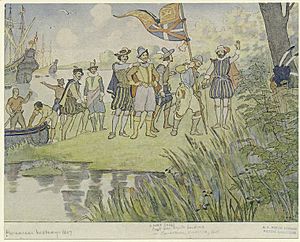
In 1607, England built a settlement at Jamestown, Virginia. This was the start of English colonialism in North America. Many English people settled there for religious or economic reasons. About 70% of English immigrants to North America between 1630–1660 were indentured servants. These were people who agreed to work for a set time to pay for their journey. By 1700, Chesapeake farmers brought about 100,000 indentured servants. They made up over 75% of all European immigrants to Virginia and Maryland.
English Civil War: King vs. Parliament
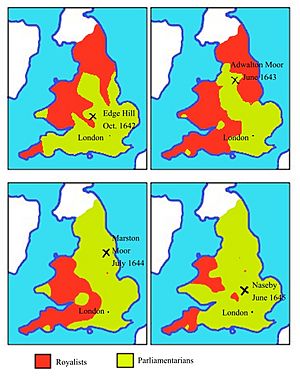
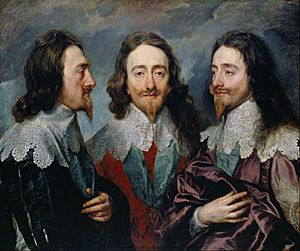
The First English Civil War began in 1642. It was caused by conflicts between James' son, Charles I, and Parliament. The King's army (Royalists) was defeated by Parliament's New Model Army at the Battle of Naseby in June 1645. Charles surrendered to the Scottish army. He was later handed over to the English Parliament in early 1647. He escaped, and the Second English Civil War began. It was a short fight. The New Model Army quickly secured the country. Charles was captured and put on trial. He was beheaded in January 1649 in London. This made England a republic, meaning it had no king. The trial and execution of Charles by his own people shocked Europe. The king argued that only God could judge him.
The New Model Army, led by Oliver Cromwell, then defeated Royalist armies in Ireland and Scotland. Cromwell was given the title Lord Protector in 1653. To those who disagreed with him, he was like a 'king in all but name'. After he died in 1658, his son Richard Cromwell took his place. But Richard was forced to leave within a year. For a while, it seemed a new civil war might start as the New Model Army split. Troops in Scotland, led by George Monck, marched on London to restore order.
Restoring the Monarchy
The monarchy was brought back in 1660. King Charles II returned to London.
In 1665, the Great Plague of London killed many people. Soon after, in 1666, the Great Fire of London burned for 5 days. It destroyed about 15,000 buildings. After the monarchy was restored, the king's power was reduced. By the 18th century, England was one of the freest countries in Europe.
The Glorious Revolution
In 1680, the Exclusion Crisis happened. Many people in England didn't like that a Catholic was King of England. After Charles II died in 1685, his Catholic brother King James II & VII was crowned. From then on, different groups pushed for his Protestant daughter Mary and her husband, Prince William III of Orange, to replace him. This event became known as the Glorious Revolution.
In November 1688, William landed in England with an army. He succeeded in being crowned king. After this, James tried to take back the throne by force in the Williamite War. William finally defeated him at the Battle of the Boyne in 1690.
In December 1689, the Bill of Rights was passed. This was a very important document in English history. It gave people more rights and put more limits on the king's power. William didn't like the limits. But he chose not to fight Parliament and agreed to the Bill.
In parts of Scotland and Ireland, Catholics remained loyal to James. They tried to get him back on the throne, but they failed.
Forming the United Kingdom
Until 1707, the Kingdom of England and the Kingdom of Scotland had one king but two separate parliaments. The Acts of Union, passed by both parliaments, declared that a single Kingdom of Great Britain would be formed. It would be governed by one Parliament. The Treaty of Union was written to make sure this rule of Great Britain happened.
The Acts took effect on May 1, 1707. On this date, the Scottish Parliament and the English Parliament joined. They formed the Parliament of Great Britain, based in the Palace of Westminster in London. This is why the Acts are called the Union of the Parliaments.
The Act of Union of 1800 joined the Kingdom of Ireland and the Kingdom of Great Britain. This created a new state called the United Kingdom of Great Britain and Ireland. London, the English capital, became its capital.
Modern England: 18th and 19th Centuries
After the United Kingdom was formed, the history of England became part of the history of the UK. England is now one of the countries of the United Kingdom.
The Industrial Revolution: A Changing Way of Life
In the late 18th and early 19th centuries, England's way of life changed greatly. It shifted from farming to industry. This was called the Industrial Revolution. Machines in city factories could make products faster than people at home. Cities became very crowded with families needing work. Many more babies and children died, crime increased, and people became poorer.
Local Government Changes
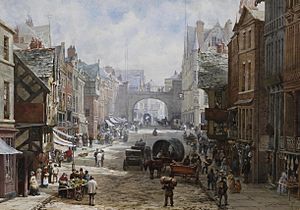
The Local Government Act of 1888 created a standard system of local government across England. County business needed to be handled better by elected officials. These officials managed smaller areas of land. The existing counties were used as boundaries for each local government.
Even with this improvement, people felt more local divisions would help. Large cities and rural areas in the same county could be managed better by separate groups. The Local Government Act 1894 created 59 "county boroughs." These were like "counties in themselves" to manage the urban centers of England.
England in the 20th and 21st Centuries
At the turn of the 20th century, land was no longer the main source of wealth for the upper classes. Farms had struggled, and land and inheritances were heavily taxed. This caused many to sell their large estates.
Key Historical and Political Events
The Anglo-Irish treaty of 1921 created the Irish Free State (now the Republic of Ireland) as a separate country. This left Northern Ireland as part of the United Kingdom (UK). So, the official name of the UK became "The United Kingdom of Great Britain and Northern Ireland."
England, as part of the UK, joined the European Economic Community in 1973. This later became the European Union in 1993.
There is a movement in England to create a devolved English Parliament. This would give England its own local Parliament, like those already in Scotland, Northern Ireland, and Wales. This issue is called the West Lothian question.
Recent Local Government Changes
In 1972, the old local administration system was completely changed. Lawmakers created a new two-level system across the country. This included metropolitan county councils and Greater London. This was called the Local Government Act of 1972. New counties were created to cover the whole country. Many were based on the historic counties, but there were big changes, especially in the north. This two-level system only lasted 12 years. In 1986, the metropolitan county councils and Greater London were removed.
The rate-capping rebellion happened in 1985. English local councils didn't like that the Conservative government, led by Margaret Thatcher, limited their spending. They tried to get these powers removed by refusing to set any budget for 1985-1986. They thought this would force the government to either help them directly or remove the restrictions. However, all 15 councils that refused to set a budget eventually did so. The campaign failed, and the government's power to limit council budgets has remained since.
In 2009, new changes to local government were made. New unitary authorities were created in areas that used to have a two-level system of counties and districts. In five shire counties, the jobs of the county and district councils were combined into one authority. In two counties, the county council's powers were taken over by fewer districts.
As part of the June 2010 United Kingdom budget, it was announced that regional development agencies were being removed. Instead, Local enterprise partnerships were being created. On June 29, the Department of Communities and Local Government and the Department for Business, Innovation, and Skills asked local leaders to send proposals for new local enterprise partnerships by September 6, 2010.
On September 7, 2010, details of 56 proposals for local enterprise partnerships were released. On October 26, 2010, 22 proposals were given the "green light" to start their plans. Others might be accepted later with changes. On October 28, 2010, 24 bids were announced as successful. As of 2021, there are 38 local enterprise partnerships (LEPs) across England.
Queen Elizabeth II ruled from February 6, 1952, until her death on September 8, 2022. Her son Charles III became king at age 73.
Fun Facts About England's History
- Winchester was England's first capital city.
- One of William the Conqueror's rules was that everyone had to be in bed by 8:00 pm.
- England hosts an annual wife-carrying race. This remembers the Vikings and how they carried women from towns during raids.
- In the 1500s, it was law for every man over six years old to wear a flat cap (hat) on Sundays.
- Henry VIII started a beard tax. If someone didn't pay it, their beard was shaved off!
- Lake Havasu City, Arizona, bought London Bridge. They took it apart and rebuilt it there.
- Llanfairpwllgwyngyll is a real town in Wales. It has the second-longest one-word place name in the world. The full name is Llanfairpwllgwyngyllgogerychwyrndrobwllllantysiliogogogoch.
Images for kids
-
Landing of the Romans on the Coast of Kent
-
Pope Gregory I seeing Anglo-Saxon children in a slave market in Rome. He sent Augustine as a missionary to England in 596.
-
King Henry VIII
-
Portrait of Edward VI, c. 1550
See also
 In Spanish: Historia de Inglaterra para niños
In Spanish: Historia de Inglaterra para niños


